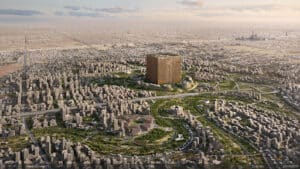It seems we can’t find what you’re looking for. Perhaps searching can help.
A REGENERATIVE APPROACH IN A CHANGING CLIMATE

This course offers a theoretically grounded yet practice-oriented exploration of how urban and architectural spaces can be conceptualised primarily for nature, positioning ecosystems, flora, and fauna as fundamental drivers of spatial and infrastructural organisation. Drawing upon regenerative design principles, participants will investigate how the built environment can adapt to climate change, enhance ecological function, reduce overall carbon footprints, and ultimately foster human well-being.
Syllabus
The curriculum commences with critically examining climate change and its impact on natural systems, utilizing Grasshopper-based digital workflows to identify stress factors such as extreme heat. Participants then investigate the Phytogenic Heat Island phenomenon, analyzing conditions under which vegetation inverts its customary cooling role when subjected to high temperatures and limited resources. Through adaptive design strategies, students will practice developing configurations that restore plant and wildlife resilience, reverting these problematic conditions toward a more balanced thermal regime.
Building on these foundational insights, the course delves into bio-enhanced design, where parametric modeling is deployed to refine buildings and landscapes to reinforce ecological processes. These computational exercises emphasize the synergy between architecture and the natural environment, showing how iterative simulations can inform design decisions that bolster biodiversity, even under progressively challenging climate scenarios. Next, the focus shifts to carbon sequestration strategies. Careful planning of vegetation in spaces, living façade systems, and ecologically driven morphologies is shown to amplify carbon storage across scales—from individual buildings to entire urban districts.
Finally, the course introduces an in-depth health discussion, spotlighting a “Spedititive Nature Calculation for Outdoor Comfort” script that models critical plant processes in near-real time. By incorporating standard meteorological inputs alongside key biophysical variables, this tool rapidly evaluates how vegetation, building geometry, and material specifications converge to shape thermal comfort and broader psychological well-being. Through this combined lens of ecological integrity, carbon reduction, and human health, participants acquire a cohesive methodological framework for designing resilient, nature-centred urban environments.
Learning Objectives
At course completion, the student will be able to:
- Identify and incorporate climate stressors—heat islands and biodiversity loss—through parametric analyses, ensuring design proposals are rooted in precise data.
- Embed regenerative concepts that foreground vegetation and ecological networks, reversing local heat build-up and revitalising ecosystems across building and urban scales.
- Refine designs of spaces, infrastructure and buildings using computational modelling to optimise nature’s health, promote continuous habitats, and reinforce built environments’ synergy with natural processes.
- Implement carbon-accounting scripts to design net-zero or carbon-negative outcomes, leveraging living and nature-driven materials for comprehensive ecological gains.
- Enhance occupant comfort and biophilic well-being by deploying digital workflows such as the “Spedititive Nature Calculation for Outdoor Comfort” to quantify vegetation’s impact on thermal environments and visual connections to greenery.



